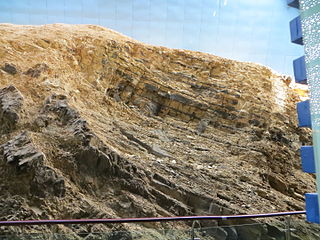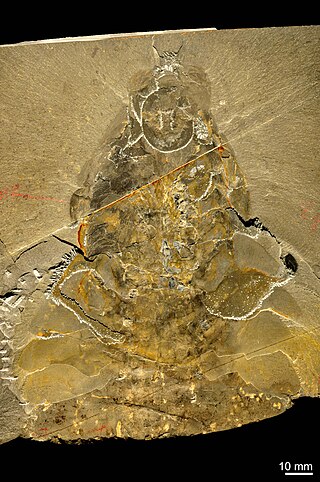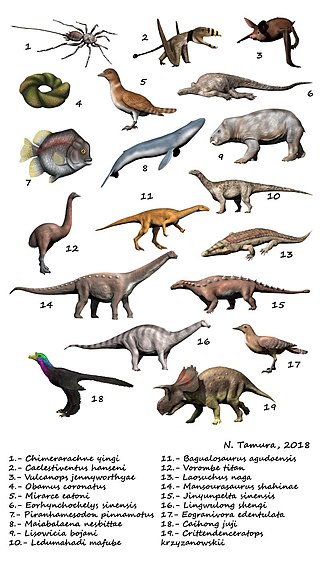
Lobopodians are members of the informal group Lobopodia, or the formally erected phylum Lobopoda Cavalier-Smith (1998). They are panarthropods with stubby legs called lobopods, a term which may also be used as a common name of this group as well. While the definition of lobopodians may differ between literatures, it usually refers to a group of soft-bodied, marine worm-like fossil panarthropods such as Aysheaia and Hallucigenia. However, other genera like Kerygmachela and Pambdelurion are often referred to as “gilled lobopodians”.

The Maotianshan Shales (帽天山页岩) are a series of Early Cambrian sedimentary deposits in the Chiungchussu Formation, famous for their Konservat Lagerstätten, deposits known for the exceptional preservation of fossilized organisms or traces. The Maotianshan Shales form one of some forty Cambrian fossil locations worldwide exhibiting exquisite preservation of rarely preserved, non-mineralized soft tissue, comparable to the fossils of the Burgess Shale of British Columbia, Canada. They take their name from Maotianshan Hill in Chengjiang County, Yunnan Province, China.

A sclerite is a hardened body part. In various branches of biology the term is applied to various structures, but not as a rule to vertebrate anatomical features such as bones and teeth. Instead it refers most commonly to the hardened parts of arthropod exoskeletons and the internal spicules of invertebrates such as certain sponges and soft corals. In paleontology, a scleritome is the complete set of sclerites of an organism, often all that is known from fossil invertebrates.

Microdictyon is an extinct armoured worm-like panarthropod coated with net-like scleritic plates, known from the Early Cambrian Maotianshan shale of Yunnan China and other parts of the world. Microdictyon is part of the ill-defined taxon – Lobopodia – that includes several other odd worm-like animals that resembling worm with legs, such as Hallucigenia, Onychodictyon, Cardiodictyon, Luolishania, and Paucipodia. The isolated sclerites of Microdictyon are known from other Lower Cambrian deposits. Microdictyon sclerites appear to have moulted; one sclerite seems to have been preserved during ecdysis.

Peytoia is a genus of hurdiid radiodont, an early diverging order of stem-group arthropods, that lived in the Cambrian period, containing two species, Peytoia nathorsti from the Miaolingian of Canada and Peytoia infercambriensis from Poland, dating to Cambrian Stage 3. Its two frontal appendages had long bristle-like spines, it had no fan tail, and its short stalked eyes were behind its large head.
The Kaili Formation(凯里組) is a stratigraphic formation which was deposited during the Lower and Middle Cambrian. The formation is approximately 200 metres (660 ft) thick and was named after the city Kaili in the Guizhou province of southwest China.
The small shelly fauna, small shelly fossils (SSF), or early skeletal fossils (ESF) are mineralized fossils, many only a few millimetres long, with a nearly continuous record from the latest stages of the Ediacaran to the end of the Early Cambrian Period. They are very diverse, and there is no formal definition of "small shelly fauna" or "small shelly fossils". Almost all are from earlier rocks than more familiar fossils such as trilobites. Since most SSFs were preserved by being covered quickly with phosphate and this method of preservation is mainly limited to the late Ediacaran and early Cambrian periods, the animals that made them may actually have arisen earlier and persisted after this time span.

The palaeoscolecids are a group of extinct ecdysozoan worms resembling armoured priapulids. They are known from the Lower Cambrian to the lower Ludfordian ; they are mainly found as disarticulated sclerites, but are also preserved in many of the Cambrian lagerstätten. They take their name from the typifying genus Palaeoscolex. Other genera include Cricocosmia from the Lower Cambrian Chengjiang biota. Their taxonomic affinities within Ecdysozoa have been the subject of debate.

Eldonia is an extinct soft-bodied cambroernid animal of unknown affinity, best known from the Fossil Ridge outcrops of the Burgess Shale, particularly in the 'Great Eldonia layer' in the Walcott Quarry. In addition to the 550 collected by Walcott, 224 specimens of Eldonia are known from the Greater Phyllopod bed, where they comprise 0.43% of the community. Species also occur in the Chengjiang biota, Siberia, and in Upper Ordovician strata of Morocco.

Hazelia is a genus of spicular Cambrian demosponge known from the Burgess Shale, the Marjum formation of Utah, and possibly Chengjiang. It was described by Charles Walcott in 1920.

Eiffelia is an extinct genus of sponges known from the Middle Cambrian Burgess Shale as well as several Early Cambrian small shelly fossil deposits. It is named after Eiffel Peak, which was itself named after the Eiffel Tower. It was first described in 1920 by Charles Doolittle Walcott. It belongs in the Hexactinellid stem group. 60 specimens of Eiffelia are known from the Greater Phyllopod bed, where they comprise 0.11% of the community.
Hamptonia is an extinct genus of sea sponge known from the Middle Cambrian Burgess Shale and the Lower Ordovician Fezouata formation. It was first described in 1920 by Charles Doolittle Walcott. 48 specimens of Hamptonia are known from the Greater Phyllopod bed, where they comprise < 0.1% of the community.

Allonnia is a genus of coeloscleritophoran known as complete scleritomes from the Middle Cambrian Burgess Shale. It is also a constituent of the small shelly fauna.
Paleontology or palaeontology is the study of prehistoric life forms on Earth through the examination of plant and animal fossils. This includes the study of body fossils, tracks (ichnites), burrows, cast-off parts, fossilised feces (coprolites), palynomorphs and chemical residues. Because humans have encountered fossils for millennia, paleontology has a long history both before and after becoming formalized as a science. This article records significant discoveries and events related to paleontology that occurred or were published in the year 2012.

Amplectobeluidae is a clade of Cambrian radiodonts. It currently includes five definitive genera, Amplectobelua, Lyrarapax, Ramskoeldia, Guanshancaris and a currently unnamed genus from the lower Cambrian aged Sirius Passet site in Greenland. There is also a potential fifth genus, Houcaris, but that genus has become problematic in terms of its taxonomic placement.
Paleontology or palaeontology is the study of prehistoric life forms on Earth through the examination of plant and animal fossils. This includes the study of body fossils, tracks (ichnites), burrows, cast-off parts, fossilised feces (coprolites), palynomorphs and chemical residues. Because humans have encountered fossils for millennia, paleontology has a long history both before and after becoming formalized as a science. This article records significant discoveries and events related to paleontology that occurred or were published in the year 2016.
This list of fossil arthropods described in 2018 is a list of new taxa of trilobites, fossil insects, crustaceans, arachnids, and other fossil arthropods of every kind that were described during the year 2018, as well as other significant discoveries, and events related to arthropod paleontology that are scheduled to occur in the year 2018.

Paleontology or palaeontology is the study of prehistoric life forms on Earth through the examination of plant and animal fossils. This includes the study of body fossils, tracks (ichnites), burrows, cast-off parts, fossilised feces (coprolites), palynomorphs and chemical residues. Because humans have encountered fossils for millennia, paleontology has a long history both before and after becoming formalized as a science. This article records significant discoveries and events related to paleontology that occurred or were published in the year 2018.

Onychodictyon is a genus of extinct lobopodian known from the Lower Cambrian Chengjiang Maotianshan Shales in the Yunnan Province in China. It was characterized by a stout body covered by fleshy papillae and pairs of sclerotized plates with spines, representing part of the diverse "armoured lobopodians" alongside similar forms such as Microdictyon and Hallucigenia.












